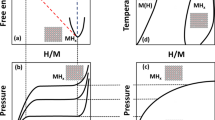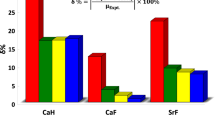Abstract
The metallic softness parameterαr 0 determines the structure of the cluster and governs the rule of magic numbers. Using molecular dynamic method, the stable structures and magic numbers are determined for the clusters consisting of 13 up to 147 atoms in medium range Morse potentials, which is suitable for most of metals. As the number of atoms constituting the cluster increases, the stable structures undergo transition from face-centered (FC) to edge-centered (EC) structures. The magic number take ones of FC series before transition and take ones of EC series after that. The transition point from FC to EC structures depends on the value of softness parameter.
Similar content being viewed by others
References
Northby J A. Structure and Binding of Lennard-Jones Clusters: 13≤N≤147.J Chem Phys, 1987,86: 6166.
Doye J P K, Wales D J, Berry R S. The Effect of the Range of the Potential on the Structure of Clusters.J Chem Phys, 1995,103: 4234.
Doye J P K, Wales D J. The Structure and Stability of Atomic Liquids: from Clusters to Bulk.Science, 1996,271: 484.
Doye J P K, Wales D J. Structural Consequences of the Range of the Interatomic Potential a Menagerie of Clusters.J Chem Soc Faraday Trans, 1997,93: 4233.
Montejano-Carrizales J M, Iniguez M P, Alonso J A,et al. Theoretical Study of Icosahedral Ni Clusters Within the Embedded-Atom Method.Phys Rev B, 1996,54: 5961.
Ikeshoji T, Hafskjold B, Hashi Y,et al. Molecular Dynamics Simulation for the Formation of Magic Number Clusters with a Lennard-Jones Potential.Phys Rev Lett, 1996,76: 1792.
Martin T P. Shells of Atoms.Phys Rep, 1996,273: 199.
Broyer M. Metallic Character of Small Metal Aggregates as a Function of Their Atomic Structures.J Noncryst Solids, 1994,156–158: 783.
De Heer W A. The Physics of Simple Metal Clusters: Experimental Aspects and Simple Models.Rev Mod Phys, 1993,65: 611.
Brack M. The Physics of Simple Metal Clusters: Self-Consistant Jellium Model and Semiclassical Approaches.Rev Mod Phys, 1993,65: 677.
Nagaev E L. Equilibrium and Quasiequilibrium Properties of Small Particles.Phys Rep, 1992,222: 199.
Upperbrink, Wales D J. Packing Schemes for Lennard-Jones Cluster of 13 to 150 Atoms: Minima, Transition States and Rearrangement Mechanisms.J Chem Soc Faraday Trans, 1991,87: 215.
Martin T P, Bergmann T, Gohlich H,et al. Shell Structure of Clusters.J Phys Chem, 1991,95: 6421.
Pan J, Ramakrishna M V. Magic Numbers of Silicon Clusters.Phys Rev B, 1994,50: 5431.
Freeman D L, Doll J D. Computationals Studies of Clusters: Methods and Results.Annu Rev Phys Chem, 1996,47: 43.
Parks E K, Zhu L, Ho J,et al. The Structure of Small Nickel Clusters: I. Ni3−Ni15.J Chem Phys, 1994,100: 7206.
Cleveland C L, Landman U. The Energetics and Sturcture of Nickel Clusters: Size Dependence.J Chem Phys, 1991,94: 7376.
Girifalco L A, Weizer V G. Application of the Morse Potential Function to Cubic Metals.Phys Rev, 1959,114, 687.
Farges J, de Faraday M F, Raoult B,et al. Noncrystalline Tructure of Argon Cluster. I. Polylcosahedral structure of ArN clusters, 20<N<50.J Chem Phys, 1983,78: 5067.
Martin T P, Naher U, Bergmann T,et al. Observation of Icosahedral Shells and Subshells in Calcium Clusters.Chem Phys Lett, 1991,183: 119.
Harris I A, Norman K A, Mulkern R V,et al. Icosahedral Structure of Large Charged Argon Clusters.Chem Phys Lett, 1986,130: 316.
Sung M W, Kawai R, Weare J H. Packing Transitions in Nanosized Li Clusters.Phys Rev Lett, 1994,73: 3552.
Harris I A, Kidwell R S, Northby J A. Structure of Charged Argon Clustes Fromed in a Free Jet Expansion.Phys Rev Lett, 1984,53: 2390.
Rayane D, Melinon P, Cabaud B,et al. Close-Packing Structure of Small Barium Clusters.Phys Rev A, 1989,39: 6056.
Parks E K, Zhu L, Ho J,et al. The Structure of Small Nickel Clusters, II. Ni16−Ni28.J Chem Phys, 1995,102: 7377.
Parks E K, Winter B J, Klots T D,et al. Evidence for Polyicosahedral Structure in Ammoniated Iron, Cobalt, and Nickel Clusters.J Chem Phys, 1992,96: 8267.
Author information
Authors and Affiliations
Additional information
Foundation item: Supported by the National Natural Science Foundation of China (19674042, 19834070), Science and Technology Program of National Education Ministry of China
Biography: Liu Hao-yang (1975-), male, Ph. D, candidate, research direction: liquid physics.
Rights and permissions
About this article
Cite this article
Hao-yang, L., Xian-wu, Z., Da-zhi, R. et al. Metallic softness influence on magic numbers of clusters. Wuhan Univ. J. Nat. Sci. 5, 301–306 (2000). https://doi.org/10.1007/BF02830140
Received:
Issue Date:
DOI: https://doi.org/10.1007/BF02830140




